by Lisa Cooke | Dec 9, 2016 | 01 What's New |
New and updated genealogical collections for the Royal Irish Constabulary are just the tip of the iceberg this week. Scroll down for more cool finds for New South Wales, Scotland, U.S. marriages, and an update to the Freedmen’s Bureau collections at FamilySearch.

Ireland – Royal Irish Constabulary Records
You can now search the Ireland, Royal Irish Constabulary Service Records 1816-1922 at Findmypast for over 486,000 records that uncover the details of your ancestor’s career with the R.I.C.
Each search result includes an image of the original document and a transcript. The nature of the information recorded will vary significantly depending on the subject and type of the original document. The following is a list of what types of records can be found in this collection:
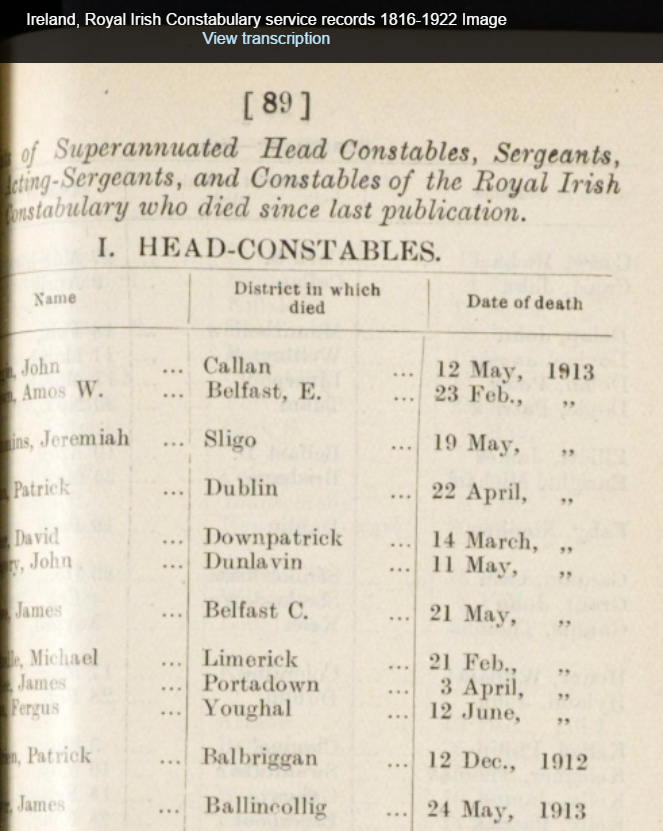
Auxiliary division general registers: These are nominal rolls that recorded member’s service number, rank, dispersed date, and company name. The registers also include division journals that recorded dates of appointment, promotions, and medical details.
Clerical staff: record of service and salaries: These lists of clerical staff include birth date, age at appointment, rank, department and salary.
Constabulary Force Funds: These correspondence registers are of members who paid into the fund with notes on whether they had been pensioned, died or received any rewards from the fund.
Constabulary lists: These are lists of chief constables created during the first year of the Royal Irish Constabulary.
Disbandment registers: These registers are of serving members who were with the force in 1922 when it disbanded after the creation of the Free Irish State. They also noted the number of years the constable served and their recommended pension.
General registers: Records of constables’ service history are contained in these general registers. The entries include the individual’s birth date, native county, religion, previous occupation, date of appointment, and promotions, as well as any rewards or punishments received and the date of pension or discharge.
Nominal returns, arranged by counties: Nominal returns are lists of all serving members of the Royal Irish Constabulary organised by county that recorded the individual’s number, rank, name, religion, date of appointment, marital status, and station location.
Officers’ registers: These registers are lists of Officers that include transfers and dates, favorable and unfavorable records, dates of promotions and details of previous military service.
Pensions and gratuities: Pension records reveal the constable’s rate of pay and the amount of pension calculated.
Recruits index: Lists of new recruits, their dates of appointment and arrival, and their company can be found in the recruits index.
Also at Findmypast, Ireland, Royal Irish Constabulary History & Directories has had a significant addition of over 43,000 records. You will be able to explore a variety of publications between the years of 1840 and 1921. These records will provide insight into the administration and daily operations of the police force.
Each record includes a PDF image of the original publication. The collection includes training manuals, codes of conduct, salary scales, circulars and staff lists that cover promotions, deployments, and rules & regulations.
Ireland – Valuation Books
At FamilySearch, the Ireland, Valuation Office Books, 1831-1856 are now available to search. These records are the original notebooks that were used when the property valuations were conducted between the years of 1831-1856. They are arranged by county, then alphabetically by parish or townland.
Land valuation records may contain the following information:
- Land occupier’s name
- Location, description, and monetary valuation of each land plot surveyed
New South Wales – Passenger Lists
The New South Wales Passenger Lists is a collection at Findmypast that contains over 8.5 million records. The collection includes records of both assisted and unassisted passengers. The assisted passenger lists cover 1828 to 1896 and the unassisted passenger lists span the years 1826 to 1900. Assisted passengers refers to those who received monetary assistance from another party or agency/government for their passage.
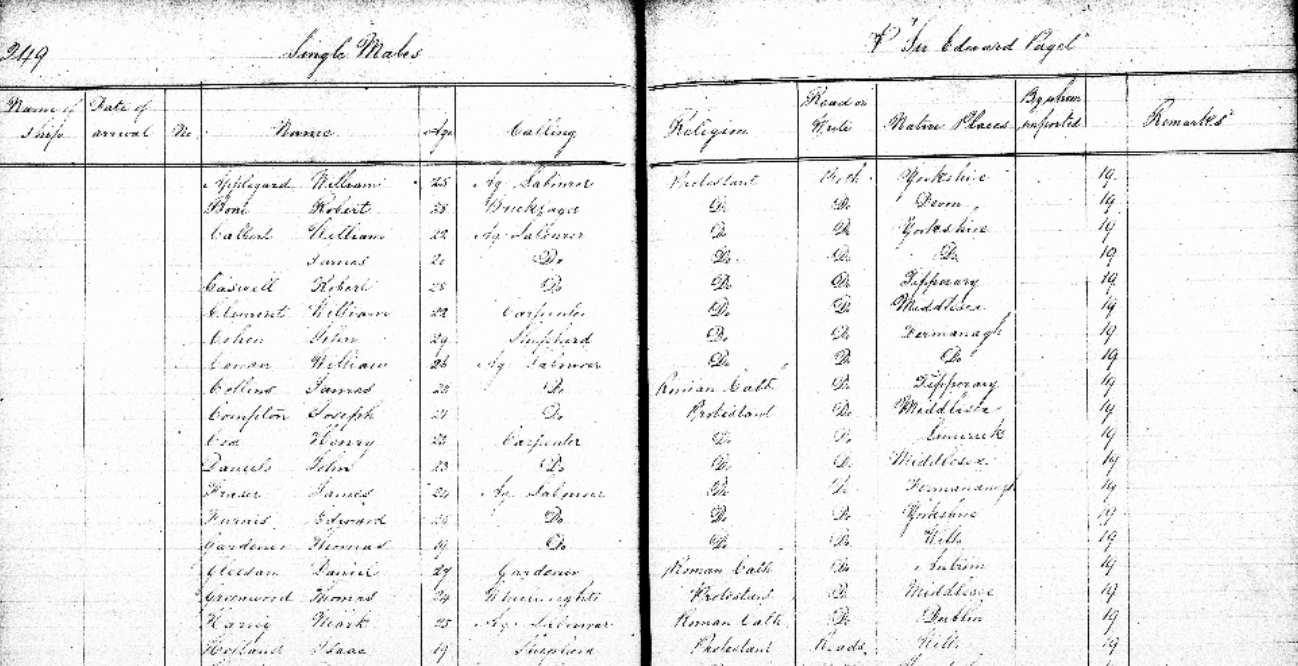
Each result will provide a transcript and image of the original record. The information included on the transcript will vary depending on whether your ancestor was an assisted or unassisted passenger, although most will include your ancestors name, passage type, birth year, nationality, departure port, arrival port and the dates of their travels.
Scotland – Parish Records
The Scotland Non-Old Parish Registers Vital Records 1647-1875 found at Findmypast is a collection of registers created by churches outside of the established church. It contains over 12,000 transcripts of births, marriages, and deaths.
Non-old parish registers are different from the Church of Scotland’s old parish records.
Though these are only transcripts and do not include a digital image of the original, you may find the following information on the records included in this collection:
With each result you will be provided with a transcript of the details found in the original source material. The detail in each transcript can vary depending on the event type and the amount of information that was recorded at the time of the event. Here are some of the facts you may find in the records:
- Name
- Birth year, date, and place
- Event year
- Event type – birth, marriage, or death
- Register name
- Parish and county
United States – Freedmen’s Bureau Records
FamilySearch has updated their magnificent collection of United States Freedmen’s Bureau, Records of Freedmen, 1865-1872. Records found in this collection include census returns, registers, and lists of freedmen. They also include letters and endorsements, account books, applications for rations, and much more. Many of the records will hold valuable genealogical data.
For a complete list and coverage table of the full collection, click here.
United States – Marriages – Oregon and Utah
Ancestry.com has recently updated two marriage collections. The Oregon, County Marriages, 1851-1975 and the Weber and Piute Counties, Utah, County Marriages, 1887-1940 have some new records. Marriage records will often provide many helpful genealogical details. Depending on the year, you may find:
- Name of the groom and bride
- Date and place of the event
- Birth dates and places of bride and groom
- Names of parents of both bride and groom
- How many previous marriages and marital status
- Place of residence of bride and groom
United States – Washington – Newspapers
Washington State historic newspapers added to their digital collection of newspapers this week. With nearly 50,000 digitized pages from historical newspapers based in Centralia, Eatonville, Tacoma, and Spokane newest titles include the Centralia Daily Hub (1914-16), The Eatonville Dispatch (1916-61) and Den Danske Kronike (1916-17), a Danish-English publication based in Spokane.
The Centralia and Eatonville papers were added this month and Den Danske Kronike was added last summer, along with the Tacoma Evening Telegraph (1886-87).
You will be able to search this newspaper collection for free from the Washington State Library website.
by Lisa Cooke | Aug 8, 2020 | 01 What's New, Elevenses with Lisa, Premium Video, Research Skills |
Episode 19 Video and Show Notes
Join me for Elevenses with Lisa, the online video series where we take a break, visit and learn about genealogy and family history. (scroll down to watch the video)
Genealogy Consultation Provides a Strong Hypothesis
My 45-minute consultation with a genealogy expert Kate Eakman at Legacy Tree Genealogists broke things wide open on my Irish family lines and gave me the information and resources I needed to make all of the progress I shared in this episode. It’s the best investment I’ve made in my genealogy in a long time. They have experts in all areas. Learn more about how easy it is to book a consultation here.
After my consultation I needed to update my research plan and get to work collecting more genealogical evidence.
Let’s quickly recap what happened when I started working on my brick wall last week in episode 18:
- Margaret Lynch’s death certificate said her parents were James Scully and Bridget Madigan.
- Her obituary said she was born in Limerick Ireland.
- There was one couple by those names in Limerick, having children and the right time. There is a gap in the records where Margaret should be.
- Her husband Michael Lynch dies in Stillwater MN. St. Michael’s Catholic church. Found their marriage record in Stillwater. It was a large booming town, and a good place to focus. The Lynch family had a farm across the river in Farmington, Wisconsin.
My research question: Was this couple we found, James Scully and Bridget Madigan, who married in Kilcolman, Limerick, Ireland in 1830, the parents of Margaret Scully?
What Kate Eakman of Legacy Tree Genealogists helped me do in my 45-minute consultation:
- Become acquainted with a variety of excellent Irish research websites
- Located the indexed marriage record for James and Bridget
- Located the original marriage record for James and Bridget
- Located the indexed baptismal records for all of the children who had James and Bridget listed as their parents.
A Genealogy Research Plan for Collecting Evidence
After the consultation I developed a new research question: Are the children that we found records for in Ireland the siblings of my Margaret Lynch?
My research plan included:
- Verify if there were any other couples by the names James Scully and Bridget Madigan married in Ireland, particularly in the time from of circa 1830. (Location of source: RootsIreland.ie)
- Search in the U.S., starting in the area where Margaret lived, for each child. I’m looking for records that name these same parents, and show the child at an age that correlates with the baptismal date.
I identified several sources I believed would help me accomplish my goals.
Marriage Records – I conducted a search for James in Bridget in all counties in Ireland. I discovered that the couple Kate found during my consultation is the only couple in the RootsIreland database with those names married in Ireland. This gives me more confidence that I have the correct couple.
U.S. Records – Armed with the names and ages of the children of James and Bridget, it was time to return to America. I needed to search U.S. records to see if any of the children came to America (perhaps living near Margaret) and if these parents were named.
Records to look for:
- U.S. Federal Census (Ancestry, FamilySearch), and State Census (Minnesota Historical Society, Ancestry, FamilySearch)
- Death records (Minnesota Historical Society, FamilySearch.)
- Newspapers, particularly obituaries possibly naming parents or Limerick. (Minnesota Historical Society, Newspapers.com)
Before I began my search I created an excel spreadsheet to capture the information. I included columns for what their ages should be in each census.

Using a spreadsheet to track my findings.
Now I was ready to start the genealogical hunt!
U.S. Census
Search each sibling one at a time in the census.
- Focus on Washington Co., Minnesota (marriage and death location for Margaret & Michael Lynch)
- Move on to Polk County Wisconsin, and greater Wisconsin.
- Search both U.S. Federal Census & State Census
- Top locations identified for this search: Ancestry.com, Familysearch.org, Minnesota Historical Society
Results:
- Found individuals matching the sons in Stillwater and Baytown (Washington County)
- Found Bridget Scully (Mother) living with various sons in various census records.
- Immigration years listed for some of Margaret’s siblings.
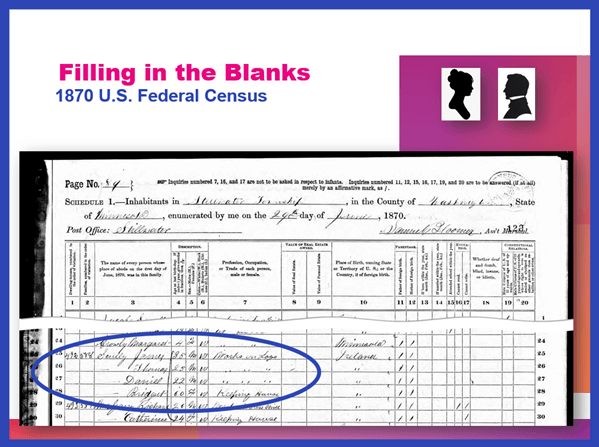
Found in the 1870 U.S. Federal Census: James, Thomas, Daniel and Bridget.
I created folders for each sibling marked MAYBE and collected the records on my hard drive.
Learn more about hard drive organization in Elevenses with Lisa episode 8.
Searched FamilySearch and the Minnesota Historical Society for a death record for each son.
- Found Thomas and James.
- James Scully and Bridget Madigan listed as parents
- Ages matched
- Next step: order the death certificates
Newspapers
Next I searched the Minnesota Historical Society website for newspapers.
Results:
- 170+ articles
- Two obituaries for Bridget Scully! (8 children, immigration year, husband died in Ireland implied)
- Found James Scully working with his brother and his obituary
Research Tip: Look at a map and identify nearby towns and larger cities. Expand your search to these areas.
I found a James Scully in the 1860 census with Bridget and his brothers, and working with Thomas in many newspaper articles.
Bridget’s obituary said she came to America with 8 children. 7 had baptismal records in Ireland. James and Margaret were not found in the baptismal records but were confirmed in U.S. records to have the same parents. That would be a total of 9 children. It’s possible one of the daughters that have not yet been found in U.S. records may have died in Ireland prior to their leaving for America.
I then combed back through my Lynch binder – I might spot something that I marked as unsure, or that might jump out at me now that didn’t 20 years ago.
- Found History of the St. Croix Valley I had photocopied a section. Names Daniel Scully (who I have since found in the census, newspapers and death records) and says his parents are James Scully and Bridget Madigan!
- Looked the book up in Google Books. It’s fully digitized. Now I can extensively read and search it.
Tech Tip: Clip and combine newspaper clippings with SnagIt software
Clipping and saving newspapers poses a unique challenge for genealogists:
- Clipping a small portion of a very large digital newspaper page can result in a low resolution file.
- If you clip an article you don’t always capture which newspaper and issue it came from
- Articles often continue in different locations on the page or pages, making it impossible to capture the entire article in one image.
I use SnagIt software to clip my newspaper finds. I can then save them to Evernote or archive them on my hard drive. SnagIt can save your clippings in wide range of file types and can even clip video. You can get your copy of SnagIt here. It’s a one time fee and download – no subscription! (Thank you for using my link – it financially supports this free without any added expense to you.)
How to combine multiple clippings with Snagit:
- Clip the paper title and date
- Clip the article
- Clip any additional applicable sections of the article
- In the SnagIt menu under Image click Combine Images
- Drag and drop the clippings into the desired order
- Click the Combine button
- Save the combined image: In the menu File > Save As (you can select from a wide variety of file types)
Research Tip: Using Street Addresses in Google Earth
When you find a street address, whether in a newspaper, city directory, census or other genealogical record, use it to find the location in the free Google Earth software program. You can then save an HD quality image of the location.
How to find a location in Google Earth (on a computer):
- Type the address into the search field in the upper left corner
- Click the Search button
- The map will automatically “fly to” the location and a pin will mark the general spot.
- Hover your mouse pointer in the upper right corner of the to reveal the navigation tools. Click the plus sign to zoom in closer.
How to view the location with Street View:
- Zoom in relatively close so that the street and buildings are distinctly visible.
- Just above the zoom tool you will find the Street View icon (the yellow “peg man”). Click on the icon and drag it over the street in front of the building / location. Don’t release your mouse. It may take a second or two for the blue line to appear indicating that Street View is available in that location. If no blue line appears street view is not available.
- When the blue line is visible, drop the Street View icon directly onto the blue line in front of the location you want to view. by releasing your mouse. If you miss the line and the picture looks distorted, click the Exit button in the upper right corner and try again.
- Once on Street View, you can use your keyboard arrow keys to navigate. You can also click on further down the street to move forward that direction.
How to save an image of a street view location:
- Position yourself in the best view of the desired location using your mouse and keyboard arrow keys as described above.
- In the toolbar at the top of the screen, click the Image icon (it looks like a portrait-oriented page, near the printer icon)
- A Title and Description box will appear at the top of the screen beneath the toolbar. Click it and type in a title and description for your image if desired.
- You can adjust the size (resolution) of the image you will be saving by clicking the Resolution button above the title box.
- When you’re ready to save the image to your hard drive, click the Save Image
Learn more about using Google Earth for genealogy in Elevenses with Lisa episode 12.

Order the video training series at the Genealogy Gems Store featuring 14 exclusive step-by-step video tutorials. The perfect companion to the book The Genealogists’s Google Toolbox by Lisa Louise Cooke.
After a week of post-consultation research:
Question: Who were the parents of Margaret Scully born in Limerick Ireland on approximately July 9, 1840?
Answer: James Scully and Bridget Madigan, married in Limerick, Ireland June 13, 1830. (Though I feel confident about this, I still have additional records I want to find in order to further solidify this conclusion.)
Question: In what Parish was Margaret Lynch born?
Answer: Most likely Kilcolman based on the baptismal locations of her siblings.
My Next Research Steps:
- Browse search through the baptismal parish records at NLI 1839-1842 for Margaret, and 1834-1836 for James Scully.
- Look for marriages of Margaret’s female siblings, and family burials.
(Contact St. Michael’s church, Stillwater, MN.)
- Go through newspapers.com – there are several Minneapolis and St. Paul papers running articles from Stillwater.
- Resume my search of passenger list records with the newly revised date of c. 1851.
- Search for the death record of Bridget’s husband James at RootsIreland and NLI.
How to Book a Genealogy Consultation
My 45-minute consultation with a genealogy expert Kate Eakman at Legacy Tree Genealogists broke things wide open on my Irish family lines and gave me the information and resources I needed to make all of the progress I shared in this episode. It’s the best investment I’ve made in my genealogy in a long time. They have experts in all areas. Learn more about how easy it is to book a consultation here.
Learn More:
For more step-by-step instructions for using Google Earth read my book The Genealogist’s Google Toolbox available at the Genealogy Gems Store.
Recommended Genealogy Gems Premium Member Videos with downloadable handouts:
Learn more about Genealogy Gems Premium membership here.
Genealogy News: Free Webinar
Watch the free video recording of my session on the MyHeritage Collection Catalog here.
Resources:
Live Chat PDF– Click here to download the live Chat from episode 19 which includes my answers to your questions.
Genealogy Gems Premium Members:
Become a Premium Member here.
by Lisa Cooke | May 6, 2014 | 01 What's New, Family History Podcast, Immigration
Family History: Genealogy Made Easy Podcast
with Lisa Louise Cooke
Republished May 6, 2014

Listen to the Family History: Genealogy Made Easy podcast by Lisa Louise Cooke. It’s a great series for learning the research ropes and well as refreshing your skills.
https://lisalouisecooke.com/familyhistorypodcast/audio/fh30.mp3
Download the Show Notes for this Episode
Welcome to this step-by-step series for beginning genealogists—and more experienced ones who want to brush up or learn something new. I first ran this series in 2008-09. So many people have asked about it, I’m bringing it back in weekly segments.
Episode 30: Immigration and Naturalization Records for Family History, Part 2
This episode continues last episode’s conversation about immigration and naturalization records. With me again is Stephen Danko, PhD, a genealogy lecturer and a very popular blogger. In today’s show Steve and I talk more about passenger lists, and some of the ramifications of an immigrant being detained or deported. We cover the multi-step naturalization process and you’ll hear about a fantastic find in naturalization papers–so fantastic that other researchers at the Family History Library in Salt Lake City wanted a copy!
Here are my favorite take-away points from this episode:
There were no requirements to keep passenger lists in the U.S. before 1820, or in Canada before 1867. (Many people originally arrived in one or the other of these countries, then migrated across the border, which was essentially unregulated before the 1890s.) There may have been records kept, but you’re not going to find them easily.
The passenger lists we’re most familiar with were filled out in the port of departure, then surrendered to U.S. government officials upon arrival. But other records were maintained at the port of departure. Departure information from European ports is often available on microfilm at the Family History Library, on Ancestry.com or other websites. Some of the passenger steamship lines themselves kept departure lists, like the White Star Line or the Red Star Line, and these are on microfilm. Here’s an excellent article on Passenger Departure Lists of German Emigrants, 1709-1914. Look for resources specific to other countries in genealogical guides under the headings “emigration” or “departure lists.”
Immigrants who were deported or even detained for further investigation, the steamship line had to pay the bill. If they were detained or they went back, the date and ship of deportation may be indicated on the passenger manifests.
Naturalization was a multistep process. The “first paper” is the declaration of intent. After a certain period of time, they applied for their petition for naturalization (“second papers”). Eventually they received their certificate of naturalization. After 1926, there may also be a certificate of arrival. (See Episode 29.)
Naturalization records may be at the county level or may be in federal court. Increasingly these are coming online. Meanwhile, some are easier to track down than others. Most Massachusetts naturalizations are available on microfilm and at the Massachusetts State Library. Some books
Many 20th-century naturalizations are packed with family information. Steve shared an example for one of his relatives. Her naturalization had her name, birthdate and birthplace, name of her husband and date of her marriage, her husband’s birthplace and date, the names of all her children, her date of arrival and the ship she came on! Some later naturalizations also have photographs. Microfilmed files may also have the certificate of arrival.
Updates and Links
About 70 million immigration and naturalization records have been indexed in recent years through an enormous community indexing project led by FamilySearch. Check out their site (below) to see what records are searchable now.
Ancestry.com
Ellis Island.org
FamilySearch.org Immigration and Naturalization Online Resources
One-Step Webpages by Stephen P. Morse (Ellis Island Search Tool)
Timeline of U.S. Immigration Laws
by Lisa Cooke | Apr 17, 2015 | 01 What's New, Ancestry, FamilySearch, images, Records & databases, United States
 Do you have family from Puerto Rico? Newly-searchable at FamilySearch.org are Puerto Rico Civil Registrations. Ancestry published these last year for their subscribers. Ancestry describes this as their “largest single collection of Puerto Rican records.”
Do you have family from Puerto Rico? Newly-searchable at FamilySearch.org are Puerto Rico Civil Registrations. Ancestry published these last year for their subscribers. Ancestry describes this as their “largest single collection of Puerto Rican records.”
According to FamilySearch, “The civil registration records in Puerto Rico are an excellent source for genealogical research after 1885. Important genealogical data can be found in these records; see below. The data may even help to find information about an earlier generation.” They include birth, marriage and death records.
The description on FamilySearch indicates that records go back to 1805. But other hints (and a comparison to the Ancestry dataset) indicate that most of the records are for 1885 and later, just like Ancestry’s. Civil registration didn’t start in Puerto Rico until 1885 (before that, look to Catholic church records for BMD data). Of course, like many records, they may contain information about family dates and relationships from earlier in that person’s life.
 Those who know about Puerto Rico’s connection to the U.S. may wonder why Puerto Rico had civil registrations at a time that U.S. states and territories did not. Puerto Rico was actually a colony of Spain when civil registration started. Only after the Spanish-American War of 1898 did Puerto Rico become a U.S. protectorate.
Those who know about Puerto Rico’s connection to the U.S. may wonder why Puerto Rico had civil registrations at a time that U.S. states and territories did not. Puerto Rico was actually a colony of Spain when civil registration started. Only after the Spanish-American War of 1898 did Puerto Rico become a U.S. protectorate.
by Lisa Cooke | May 5, 2017 | 01 What's New, Digital Archives, Records & databases
Millions of New England vital records are among newly-published genealogy records online. So are English parish records, Irish Easter Rising records, Italian civil registrations, South African church records, and records for Georgia WWI soldiers and Louisiana women.
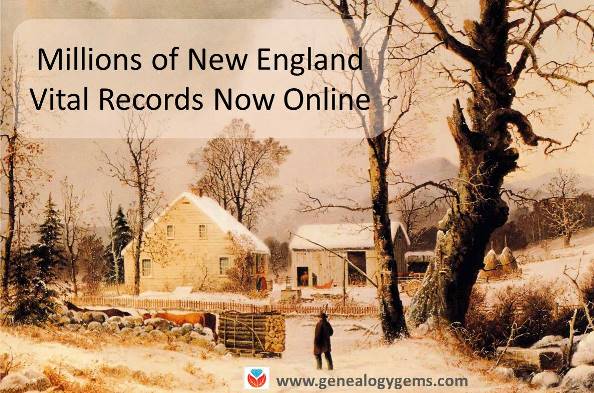
New online this week are millions of new genealogy records from around the world! First, we’ll feature these (mostly) free vital records collections for New England states–but keep scrolling. We’ve got records to mention for other parts of the U.S., as well as England, Ireland, Italy, and South Africa.
New England Vital Records
New England vital records online got a BIG bump this week with the following additions:
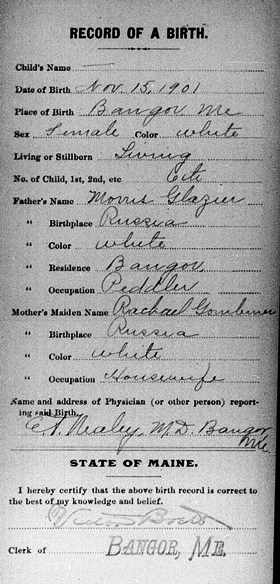
Sample image from “Maine Vital Records, 1670-1921.” Database with images. FamilySearch. http://FamilySearch.org : 2 May 2017. Citing Division of Vital Statistics. State Board of Health, Augusta. Click to view.
Connecticut. More than 755,000 indexed names have been added to FamilySearch.org’s free collection, Connecticut Marriages, 1640-1939. This hybrid index/image collection has this note: “We have legal rights to publish most of the images associated with these records; however, there are a few records that will not have an accompanying image available for view.”
Maine. FamilySearch.org has added nearly a half million indexed names to its collection of Maine Vital Records, 1670-1921. According to the site, the collection is comprised of a “name index and images of birth, marriage, and death returns acquired from the State Board of Health, Division of Vital Statistics and the state archives.”
Massachusetts: New images have been added to the New England Historic Genealogical Society’s collection for the Roman Catholic Archdiocese of Boston, 1789-1900. The update includes the following volumes: Immaculate Conception (Salem), St. Mary (Salem), and Sacred Heart (Roslindale).
Rhode Island. FamilySearch has added over a half million new indexed names and 30,000 digital images to its free collection, Rhode Island – Vital records. These are described as “Certificates and registers of births, 1846-1898, 1901-1903, marriages 1901-1903 and deaths, 1901-1953 acquired from the State Archives in Providence.”
Other new and updated records in the US include:
- Newspapers – Baltimore MD and Hartford CT. Newspapers.com has added issues for two major papers: the Baltimore Sun (1837-2017) and the Hartford Courant (1764–2017). (With a Newspapers.com Basic subscription, you can access issues of these papers through 1922; or, with a Publisher Extra subscription, access those early years and additional issues from 1923 onward.)
- Georgia. A memorial book for Georgia soldiers who served in World War I is being updated to include the names of African-Americans who served. “Due to the social and racial conditions of the time, this Memorial Book contains the information for only white soldiers,” explains the database landing page on the free United States World War I Centennial Commission website. “The current project is rectifying this by adding information for Georgia’s African-American personnel that also died in service. Further, we are adding names found on WWI monuments and plaques that are missing from the original Memorial Book….As missing names are determined and documented, they will be added” We learned about it in this press release from the University of North Georgia.
- Louisiana. A collection of digitized publications by the Louisiana United Methodist Women (and predecessor organizations) is now free to search at the Centenary College of Louisiana Archives & Special Collections web portal (scroll down to Digital Collections and click Louisiana United Methodist Women’s Publications). According to an announcement by the college, “The digitized material includes annual reports (1884-2014) and newsletters (1963-2006) – 12,000 pages in total. Researchers can access them online, page through each volume, download complete PDFs, and search the full text versions.” Published digitized material is easy to keyword-search for ancestors’ names and hometowns. Here’s a general tip for finding married women’s names in older documents: search on just her surname or her husband’s name, as she may appear as “Mrs. Alexander Reed.”
England: Newspapers and Parish Records
The British Newspaper Archive has added two new titles, The Yarmouth Independent (a Norfolk paper, 1862-1891) and The Rugby Advertiser (a Warwickshire title, 1850s-1950s).
Subscription website TheGenealogist has published over 100,000 parish records and thousands of voter records. According to the announcement, polls books include “35 different registers of people who were entitled to vote in Wakefield, West Yorkshire and other constituencies situated in Hampshire, Gloucestershire, Somerset and New Westminster in Canada….Electoral records are taken from the official lists produced to record who was entitled to vote in the various parliamentary elections.” Among new parish record collections are “100,000 new individuals added for the County of Worcestershire and additionally the Registers of the Parish Church of Rochdale in Lancashire that covers the period between 1642 and 1700.”
Findmypast.com has added 312,000 new records to its collection of Kent marriage records. New additions are for the parishes of Bapchild, Biddenden, Kilndown, Tenterden, and Wittersham. Additionally, over 18,000 new records have been added to Kent Baptisms (parishes of Bapchild, Brompton, Chatham, New Gillingham, Wingham and Wittersham); over 3,000 records have been added to Kent Banns (parishes of Bapchild, Biddenden, and Wittersham); and over 18,000 new records are in Kent Burials (parishes of Bapchild, Kilndown, Tenterden, and Wittersham).
The site has also added to its records for North West Kent, described as “areas within the London boroughs which were historically part of Kent.” Over 23,000 records have been added to the North West Kent Baptisms collection, and another 15,000 to North West Kent Burials.
Ireland – Easter Rising and Newspapers
Findmypast.com has added over 76,000 records to its collection, Easter Rising & Ireland Under Martial Law 1916-1921. According to the site, “These once classified records, digitized from original documents held by The National Archives in Kew, record the struggles of life under martial law in Ireland and contain the details of soldiers and civilians who participated in or were affected by the Easter Rising of April 1916.”
“Your ancestor may be found in the records if they were killed or wounded during the conflict, arrested and held in internment, or tried by court martial. Additionally, if their home or place of work was searched they may appear in the records as the collection shows the efforts of the military and police to discover arms, ammunition and seditious material through thousands of raids.”
Also, Findmypast.com has added over 401,089 new articles and one new title to its collection of historic Irish Newspapers. The Ballymena Weekly Telegraph is the latest publication to join the collection and currently covers the years 1904, 1906-1916, 1921-1929 and 1931-1957.
 Italy – Civil Registration
Italy – Civil Registration
FamilySearch.org has added to its free online collections of Italy’s civil registration records. Among them are:
- Trapani, 1906-1928; 1.1 million images added to an existing collection
- Brescia, 1797-1815, 1866-1943; 620,801 new browseable image
- Napoli, 1809-1865; 164,991 images added to an existing collection
- Benevento, 1810-1942, over a million images added to an existing collection
South Africa – Church records and civil death records
FamilySearch.org has added more than 61,000 digital record images and over 3,000 indexed names to its collection, South Africa, Dutch Reformed Church Records (Stellenbosch Archive), 1690-2011. Also updated at FamilySearch.org is South Africa, Cape Province, Civil Deaths, 1895-1972, with over 16,000 new names.
 Keep up with genealogy news from around the world with Lisa Louise Cooke’s FREE Genealogy Gems weekly e-newsletter. You’ll get a free Google Research e-book as a thank-you gift when you do. From this page (or any other on this website), just enter your name where it says “Sign up for the free email newsletter” and click GO.
Keep up with genealogy news from around the world with Lisa Louise Cooke’s FREE Genealogy Gems weekly e-newsletter. You’ll get a free Google Research e-book as a thank-you gift when you do. From this page (or any other on this website), just enter your name where it says “Sign up for the free email newsletter” and click GO.






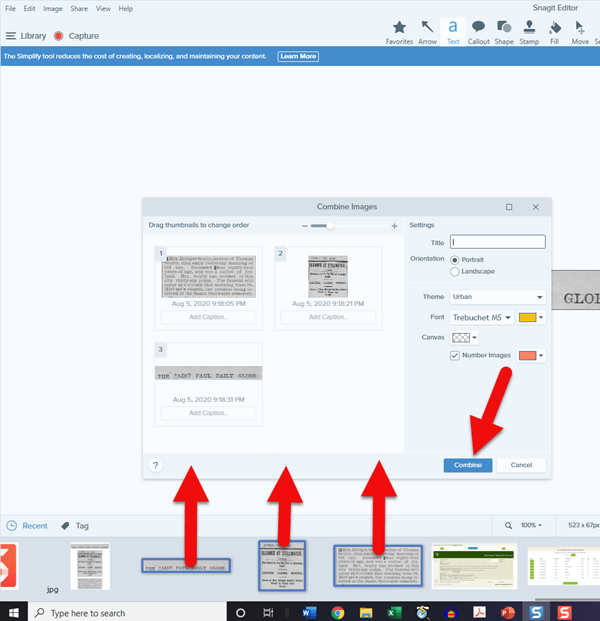






 Italy – Civil Registration
Italy – Civil Registration Keep up with genealogy news from around the world with Lisa Louise Cooke’s FREE Genealogy Gems weekly e-newsletter. You’ll get a free Google Research e-book as a thank-you gift when you do. From this page (or any other on this website), just enter your name where it says “Sign up for the free email newsletter” and click GO.
Keep up with genealogy news from around the world with Lisa Louise Cooke’s FREE Genealogy Gems weekly e-newsletter. You’ll get a free Google Research e-book as a thank-you gift when you do. From this page (or any other on this website), just enter your name where it says “Sign up for the free email newsletter” and click GO.